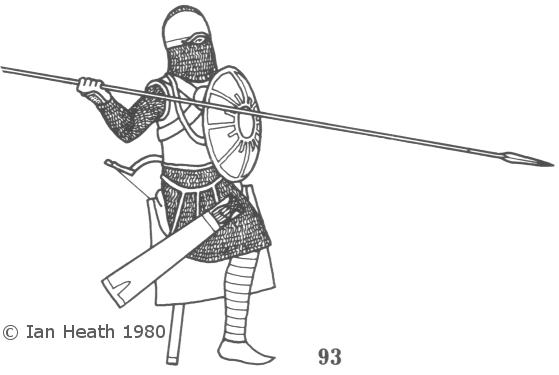LATE SASSANID CLIBANARIUSAn extract from Armies of the Dark Ages 600-1066by Ian Heath  93. LATE SASSANID CLIBANARIUS |
LATE SASSANID CLIBANARIUSAn extract from Armies of the Dark Ages 600-1066by Ian Heath  93. LATE SASSANID CLIBANARIUS |
The clibanarii were the backbone of the Sassanid army, being supplied by warrior-nobles, their retainers, and professional soldiers. The term clibanarius itself probably derived from the Persian grivpanvar, 'neck-guard wearer', in the same way as the later European term hauberk derived from halsberge, 'neck protection'.
This figure is based on existing rock reliefs and a list of regulation equipment of the reign of Chosroes I (531-579), recorded by the later Arab author Tabari.
The list requires each man to appear on parade with mail, breastplate, helmet, greaves, lance, shield, sword, mace, axe, quiver with 30 arrows, bowcase with 2 bows and 2 spare bowstrings, and horse-armour. An alternative rendering by the Persian author Balami gives vambraces instead of greaves so probably both were worn; certainly both appear in the reliefs, as does foot-armour. However, it seems unlikely that many clibanarii appeared with their full quota of equipment, and quite possibly in practice they were not expected to. It is more probable that the list only applies to regular elite regiments such as the Pushtighban (the Imperial Bodyguard, 6,000 strong under Chosroes II, 591-628), the Immortals (10,000 strong) and the Gyanavspar (literally 'Sacrificers of their lives').
Bows were fired with a curious 3-finger draw with the arrow to the left of the stave, as opposed to the usual oriental thumb-draw described under 107. The lance, which was up to 12 feet in length, was used overarm held in either one or both hands.
The breastplate was worn either over the mail corselet as here, or underneath it, as is presumably the case with the outstanding equestrian relief of Chosroes II at Taqi Bustan. The straps, which cross at the back, are held by a clasp on the chest. This is the normal Sassanid method of securing the breastplate.
The shield here, from the Chosroes II relief, carries a device representing the rays of the sun (the Sassanids being Zoroastrians). The laminated greaves (vambraces would be the same) are based on a variety of other sources. Lamellar armour was also in common use.
The clibanarii rode partly (sometimes fully) armoured horses as described in 'The Armies and Enemies of Imperial Rome'. Light cavalry are described in the same book, though others would be similar to the Sogdian described under 95 here. Some Asiatic auxiliaries were also used for this arm, notably White Huns in the early-7th century and Turks in the late-6th and early-7th centuries.